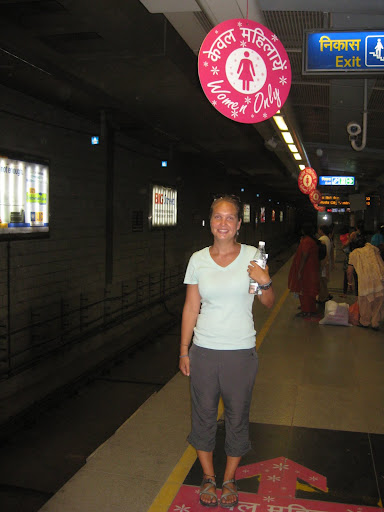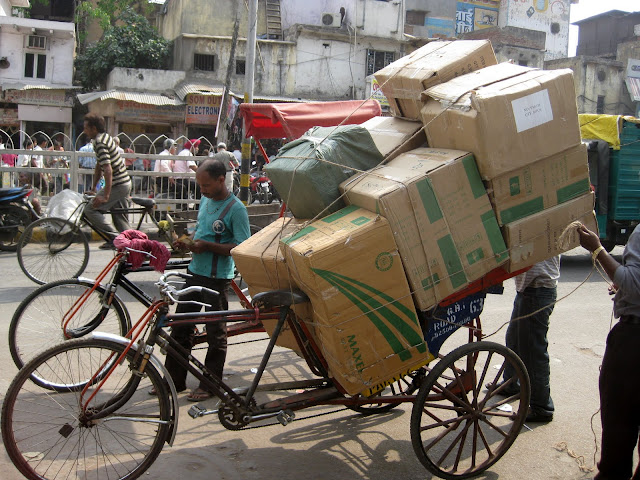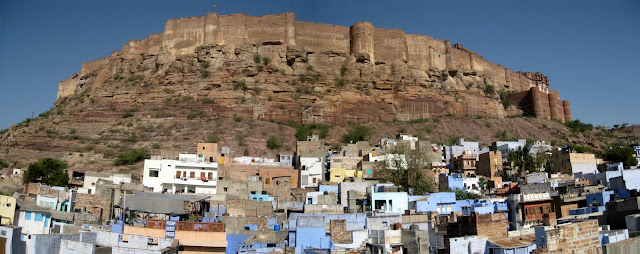For Day 2 in Delhi, we had an equally ambitious day planned that would take us into the heart of Old Delhi. We opted to take the city metro and we were beyond impressed. Not only could we effortlessly travel to all the main tourists destinations but the metro was the cleanest, most secure and easiest to navigate subway that either of us had ever experienced. NOT what we were expecting at all and a welcome treat. As it turns out, the city hosted the Commonwealth Games in 2010 and the completion of the metro coincided with this important international event. Side note – Particularly awesome about the Delhi Metro: women-only cars. A welcome relief from all the Indian men’s smells and stares!

Women Only Section!
Our first stop to Connaught Place, a conglomeration of shops, restaurants and travel agencies, was uneventful except for our first run-in with one of India’s notorious touts. We were looking for India’s official office of tourism (a notoriously hard place to find), however, the seemingly helpful concerned citizen instead had us follow him around for several blocks with plans to take us into his friend’s cousin’s brother’s sketchy travel agency. Needless to say, we figured it out rather quickly and had some steps to retrace. Foiled!
Our next plan was to head to the train station to pre-book our onward tickets to our next stop in India. The Old Delhi train station is such an overwhelming, dirty, confusing, loud place that they have an upstairs room of the station dedicated solely to helping foreigners buy actual train tickets to their desired destination for the correct price. The guidebooks warn you, “Don’t believe anyone you meet in the station that tells you the office doesn’t exist, or that it has moved locations or that it has burned down”. Apparently, there are enough fakes out there that have illegitimately separated tourists from their money that they had to create this office to begin with and then warn people to persevere to find it! We did find it, but the line to meet with an agent was literally all the way around the room. After over an hour of waiting, we found our desired trip was full and since we didn’t have a back-up plan lined up, we walked away having purchased nothing. Foiled!
Our plan to take the lovely, beautiful metro to our next stop was also unsuccessful. The metro stop below the train station is probably the busiest one in the whole city. The line to buy tickets, plus the line to get through security (yes, they have separate male and female lines for body pat-downs and an X-ray machine!) were both over 100 people long. After extensive waiting in the train office, we did NOT want to wait again (in hindsight, waiting would have been the best move). Foiled!
We decided to take an auto-rickshaw instead. However, as we were at the train station where many people arrive and need rickshaws, and because we are white tourists, the price we were quoted was astronomical. We asked 5 different drivers with no significant budge in the price. How about using the meter? Absolutely not! Foiled!
We opted for a cycle-rickshaw instead, as Old Delhi was not too far away. This was moderately successful though it involved a very skinny and rather old man using all his might to move his bicycle and our large, American bodies through the most insanely unproductive, inconsiderate traffic that we’ve ever experienced. Trucks, buses, cars, auto-rickshaws, bicycle-rickshaws, mopeds, children, cripples, cows, and chickens are all going whichever way they want to go with little to no regard to any other moving object in their way. It’s chaos and total gridlock. What should have taken 5-10 minutes took well over a half hour. Semi-foiled!

Old Delhi - crazier than it looks here

Cycle Rickshaws - when they're not full of people
We finally got close enough to our desired destinations that we opted to bail on the cycle-rickshaw (the traffic had clogged up again) and walk our buns the rest of the way. Walking wasn’t much easier. Sidewalks don’t quite exist and every step is a conscious thought that involves avoiding the street traffic and making sure you don’t walk into cow poo, a mysterious dark liquid, someone’s lap, or a man urinating.

These pictures really don't do justice to the chaos of Old Delhi

Old Delhi from above
We were hot, we were tired, we were hungry. We ate, we relaxed, we attempted to gather up the energy to head back out and visit our planned tourist destinations. However, we looked at our watch, saw it was late afternoon, realized the monuments would be closing and that Sasank would be home from work soon. So after hours of attempting to get to where we were at that exact moment, we turned right around, found the nearest metro, and called it a day with little to show for ourselves. Foiled indeed.
We returned home dirty, exhausted, and unaccomplished. Old Delhi had shown us a little taste of the India we had in store for us ahead, and we now understood the previous warnings from other travelers. India had gotten our attention that day, and it wouldn’t let it go for the rest of the trip. This would not be the first nor the last day we would be foiled by India!


